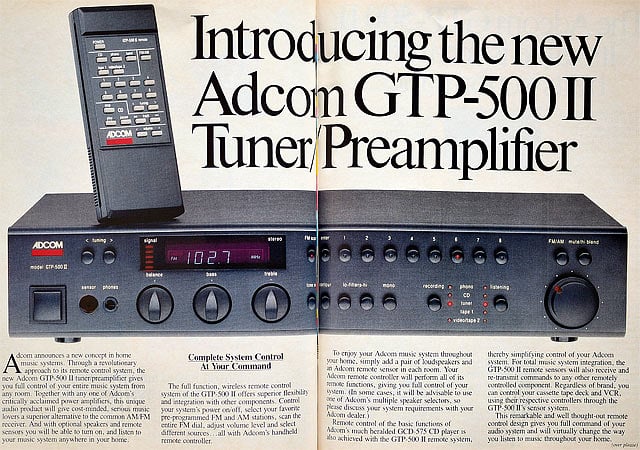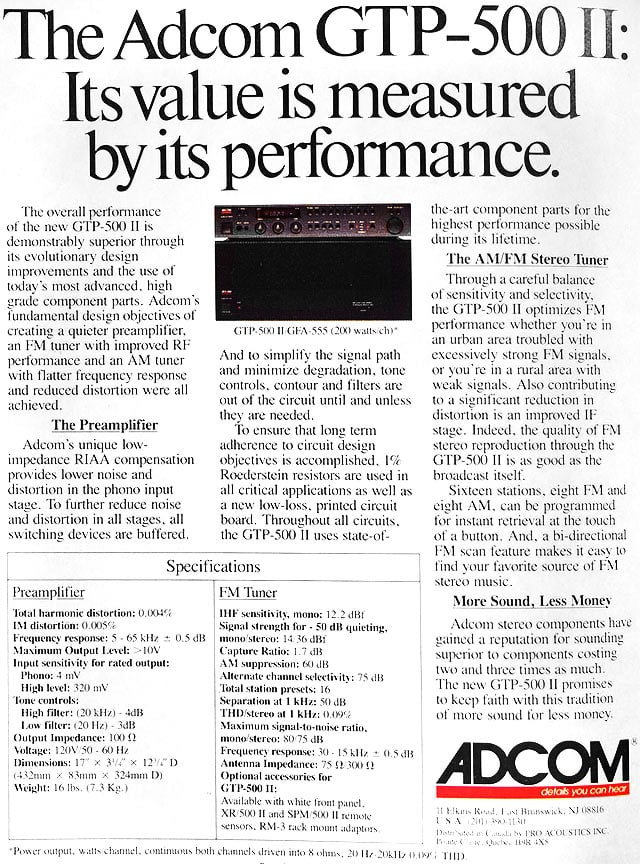Home Donate New Search Gallery Reviews How-To Books Links Workshops About Contact
ADCOM GTP-500 II
Preamp & Tuner w/remote (1988-1993)
© 2014 KenRockwell.com. All rights reserved.
Intro Specifications Measurements Usage Recommendations More
ADCOM GTP-500 II. enlarge.
Rear, ADCOM GTP-500 II (about $150 used). enlarge. This free website's biggest source of support is when you use these links, especially this link directly to the ADCOM GTP-500 II at eBay (see How to Win at eBay), when you get anything, regardless of the country in which you live. Thanks! Ken.
August 2014 ADCOM Reviews Audio Reviews All Reviews
Introduction top
Intro Specifications Measurements Usage Recommendations More
|
Adorama pays top dollar for your used gear. I use these stores. I can't vouch for ads below. |
Perspective
The ADCOM GTP-500 II is an analog preamplifier with a built-in AM-FM stereo tuner. Use it as your control center on your desk, add a remote power amp and speakers, and you've got a first-rate hi-fi system.
A pleasant feature of this all-analog preamp is a remote control. The tuner is a quartz synthesizer, the volume control is a motorized potentiometer, and input switching is electronic. Put this in your rack, retire to your chair with the remote, and enjoy it in your music room.
Plug your power amps and the rest of your system into the switched outlets on the back, and with the optional remote control you can turn everything on and off from across the room.
ADCOM pitched these in the 1990s as "the cure for the common receiver," because when teamed up with any power amp, like ADCOM's own, you have a complete AM-FM stereo receiver.
Unusual is true DC-coupling. The GTP-500 II amplifies and controls audio flat down to DC, unless you switch-in the Tone Controls or use the AC ("Normal") preamp outputs.
The ADCOM GTP-500 II has a high-output, zero output-source-impedance (less than 0.2 Ω!) dedicated headphone amplifier with a professional ¼" socket.
This is a 2011 test of an unmodified unit built 20 years ago.
Sound
Its sound is neutral, however colored by some channel imbalance from the relatively inexpensive ganged potentiometer used to control volume. More serious preamps like the Apt Holman Preamp and the Quad 34 use genuine laser-trimmed stepped attenuators instead of pots. The ganged pot in preamps like the ADCOM GTP-500 II wholesale for about 30¢, while stepped attenuators wholesale for about $30. This is the biggest audible limitation of most analog preamps.
The balance control is a typical attenuate-one-channel-at-a-time type.
With low-impedance, high-sensitivity headphones like the Ultrasone Edition 8 there is some slightly audible noise from the headphone amplifier.
The Contour (loudness) control is excellent: it's not boomy and doesn't boost the treble. The Contour control is at least as good as those on 1950s and 1960s integrated tube amplifiers that boosted the deep bass and left the rest alone. The GTP-500 II's contour control is uncanny in bringing out astonishing levels of very deep bass when a full-range system is played at very low levels. Likewise, the Bass control also works great, never making the bass boomy. The treble control affects only the higher treble. The tone circuit doesn't degrade the sound — and is bypassed unless deliberately engaged anyway.
All of the Bass, Treble and Balance controls are center click-stopped.
The input selectors are reasonably click-free as inputs are selected. Since the remote makes it easy to select between alternate inputs with dedicated buttons, it's easy to compare different input sources, like your Krell SACD player at the CD input and the CD on the same hybrid disc ripped into iTunes and played remotely from the iPod Touch in your hands via AirPlay with an Apple AirPort Express connected to the TAPE 1 input.
I do lab reports first to make sure that this 20-year-old piece of used gear gotten from a stranger over eBay isn't going to go unstable and blow my ears or tweeters, so you'll see an extensive lab report below. I'll be adding more about how it actually sounds as I spend more time with it.
As I do spend more time with it, it sounds smooth, with a perfect combination of warmth and sweetness, especially when listening at low levels with the Contour engaged. At all levels except those loud enough to duplicate a live performance, the Contour control works fantastically to replace the very deep bass that otherwise goes unheard.
Mechanical
The case is sheet metal, the front panel is anodized aluminum and the knobs and buttons are plastic. The four feet are hard plastic. All markings are painted.
Electrical
It's got a fat 16 AWG power cord, with plenty of extra insulation to impress the innocent, but it's only 5½ feet long.
It has two switched and an unswitched polarized outlet.
It draws about 16 watts as I measured it, and draws 5 watts even when turned-off to keep the remote control receiver alive.
Ergonomics
The real volume control knob works great, and so does the motor controlling it remotely.
The click-stops on Bass, Treble and Balance are wonderful, as are their knobs. It's sad how many other preamps make this difficult with either screwy knobs, or skipping the zero detents.
The black push buttons don't make their positions obvious when viewed any further away than a foot.
Input selectors are debounced: you have to tap them for more than a millisecond or they ignore you. I'd prefer direct-entry buttons to having to run through all the options each time, but tough.
The remote control controls most functions, except for Balance, Bass and Treble, which are analog controls without motors. The remote also lacks the MONO switch, which is a real analog switch on the GTP-500 II, which would have been handy for speaker and head positioning.
The remote only controls the Listening selection. It cannot control the Recording selection, so forget trying to use a tape look as an external-processor loop and then being able to select Listening inputs remotely. (When a tape loop is used as an EPL, the Listen input is set to Tape 1 or Tape 2, and the Listening inputs are selected with the Recording control.)
The motorized remote-controlled Volume pot runs at just the right speed via the remote control. I wished its LED blinked as it moved as it does on my Sony CDP-X303ES, but tough, and that the Volume LED were visible from all angles and that the faceplate indices were illuminated, but tough.
Tuners
The tuners are surprisingly great for real-world use.
Most people never use more than a crappy FM dipole antenna, and with that, the ADCOM GTP-500 II is much freer from distortion and noise than more advanced tuners like the Kenwood KT-917 to which I compared it. Even with a dipole, this ADCOM brings in more cleaner than any of the other tuners I've tried. I haven't tried it with a proper roof-mounted directional FM antenna on a rotor.
The AM tuner, with the included loop antenna, was also quite a surprise. While its frequency response is as crappy as almost every other AM radio, it was far more free from birdies, whistles, static and interference than all of my other AM tuners.
The tuner uses a non-multiplexed vacuum fluorescent display.
It's set back into the case, so the top becomes hidden when viewed from above about a 40° vertical viewing angle.
It's easy to tune, with your easy selection of either Scan or Manual modes for the up/down buttons.
Scan works great, stopping right where I want it to — but it only scans on FM.
The tuner's bright, real-time, 5-red-LED S meter also works much better than the delayed and coarse indications of most other tuners. The 5 segments are well calibrated to show meaningful differences between stations, both AM and FM.
The tuner combines the UNMUTE and HI-BLEND button. It has no automatic hi-blend on weak stations, so if you want to hear weak stations, the strong stations will be hi-blended, or the weak stations will be muted. This isn't as big a deal as it seems, because the hi0blend is much milder than other tuners and this tuner has much less noise when used with crappy antennas in real-world reception than other tuners.
The tuner stores its memory settings with an internal capacitor. It stores its settings for at least 11 days when left unplugged.
Pages 1 and 2, ADCOM GTP-500 II ad, October 1990. bigger.
Page 3, ADCOM GTP-500 II ad, October 1990. bigger.
Specifications top
Intro Specifications Measurements Usage Recommendations More
See the ADCOM GTP-500 II Service Manual for more specs and typical performance curves.
Inputs
Line
35 kΩ.
320 mV for 2V rated output (15.9 dB gain).
Phono
47kΩ, 100 pF .
4 mV for 2V rated output (54.0 dB gain).
Outputs
Two MAIN outputs, one DC coupled ("LAB") and one AC coupled ("NORMAL", AC-coupled from the DC output).
100 Ω source impedance.
Two tape outputs: 475 Ω source impedance.
One ¼" headphone output from a separate amplifier.
Output Levels
2 V RMS rated.
10 V RMS maximum.
Frequency Response
Line
5 - 65,000 Hz ±0.5 dB.
Phono (RIAA EQ)
10 - 50,000 Hz ±0.5 dB.
Distortion
Line
Less than 0.004% THD+Noise at rated output (2V).
Less than 0.005% SMPTE intermodulation distortion (60/7k Hz 4:1) at rated output (2V).
Phono
Less than 0.025% THD+Noise at rated output (2V).
Less than 0.006% SMPTE intermodulation distortion (60/7k Hz 4:1) at rated output (2V).
Noise (A-weighted RMS referred to 2V RMS)
Line
-100 dB.
Phono
-84 dB.
Crosstalk
-80 dB at 1 kHz.
Tuners
FM
87.5 ~ 108.0 MHz in 0.1 MHz steps, 75 µS de-emphasis, USA (internal jumpers can set to European 50 µS de-emphasis).
AM
530 ~ 1600 kHz in 10 kHz steps, USA (internal jumpers can set to European channel spacing).
Power
120V AC, 50-60 Hz.
0.5A 250V rear fuse.
Rated 20 W power consumption.
I measure 15.45 watts power consumption, up to a maximum of 18.5W when driving a 37.5 Ω load at maximum sinewave output level.
I measure 4.8 watts power consumption when off; the GTP-500 II's infrared remote receiver is always on, waiting for the remote control signal to wake up the rest of the circuitry.
5.5 foot, 16 AWG polarized power cord.
Two switched outlets rated 500 VA. I tried, and a 200 WPC ADCOM GFA-555 II seems perfectly happy running from the switched outlet.
One unswitched outlet rated 800 VA maximum.
Accessories
Included: 4-foot stereo RCA cable, 130 pF low-capacitance, gold connectors, clear jacket with copper braid.
Optional RC-500 II Remote Control:
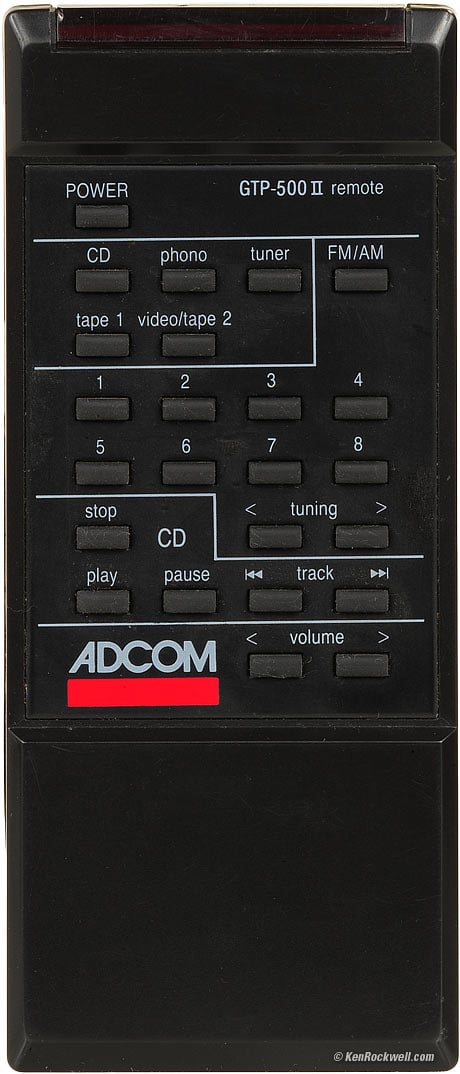
ADCOM RC-500 II Remote Control.
Optional XR-500 II and SPM-500 II remote sensors to allow control from other rooms.
Optional IRA-500 II infrared repeaters to control other brands of components from other rooms as received by the XR-500 II or SPM-500 II remote sensors.
Optional DIN-575 cord to plug ADCOM GCD-575 CD player into the GTP-500 II to allow it to be controlled by the RC-500 II remote control.
Optional RM-3 19" rack mount adapter.
Size
Chassis: 17 x 11-3/8 x 3 inches (432 x 289 x 76 mm) WHD.
Overall: 17 x 12-3/4 x 3-1/8 inches (432 x 324 x 81 mm) WHD.
Weight
12.5 pounds (5.7 kg).
16.5 pounds (7.5 kg), packed.
Quality
Made in USA.
Price, USA
December 2011: about $150 used.
From
1988 ~ 1992 its list price was $599.95, increasing 5¢ to $600 in
1993. It vanished in
1994, replaced by video and surround units.
Measurements top
Intro Specifications Measurements Usage Recommendations More
Frequency Response Maximum Output Output Source Impedance
Distortion Gain, Tracking & Balance Noise Crosstalk
Contour Tone Controls Filters Tape Outputs
Phono Preamp 600 Ω loads Headphone Amplifier
I used a state-of-the-art Rohde &Schwarz UPL for these measurements. I tested a 20-year old unit today in 2011.
Unless mentioned otherwise, they are measured with the GTP-500 II set to unity gain (about noon to 1 o'clock on the volume control), measured from the CD input to the LAB output, no filters and no tone controls, loaded with the 200k Ω load of the Rohde &Schwarz UPL.
The traces are color coded for the Left Channel and for the Right Channel. When they don't lie on top of each other, it's due to channel imbalance.
Frequency Response: +0.01, -0.06 dB top
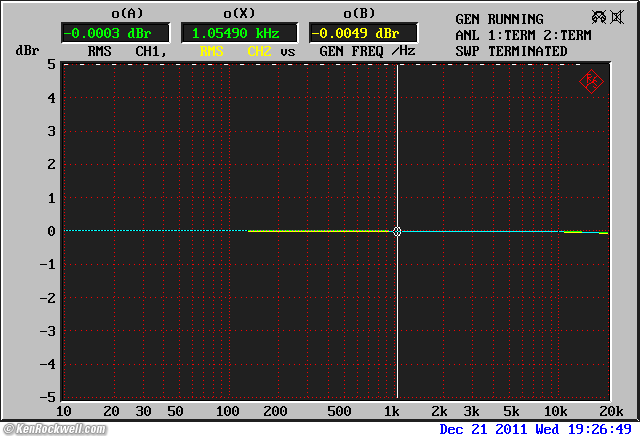
LAB Output Frequency Response, ADCOM GTP-500 II.

LAB Output Frequency Response, ADCOM GTP-500 II, expanded scale.
It's flat to +0.02, -0.06 dB from 10 - 20,000 Hz. This is flatter than most audio analyzers!
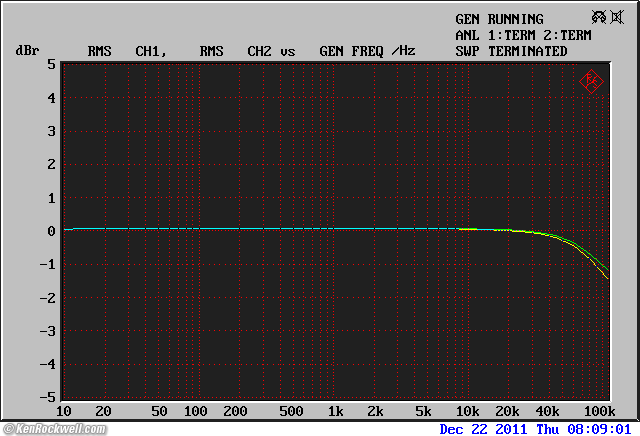
LAB Output Frequency Response, ADCOM GTP-500 II, to 110 kHz.
It's down less than 1.5 dB at 110kHz.
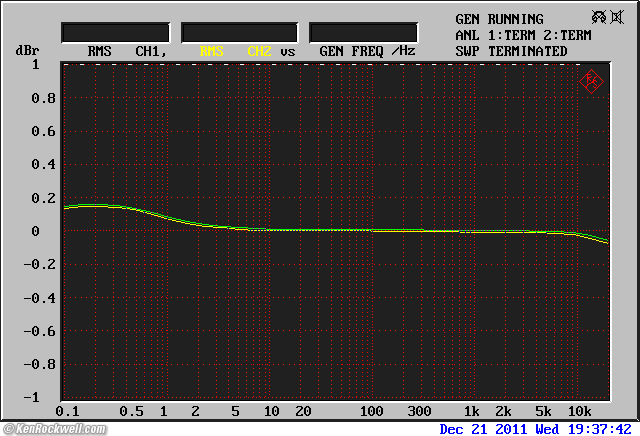
LAB Output Frequency Response to 0.1 Hz, ADCOM GTP-500 II, expanded scale.
Even crazier, it's flat measured down to DC (not shown). I have no idea why there's an 0.18 dB peak at 0.2 Hz (one cycle every 5 seconds).
I confirmed DC response from all of the CD, Tape 1 and Tape 2 inputs. I put in 1 VDC, and at unity gain, got 1 VDC at the outputs! The Phono section also appears to have response to DC.
I'll cover the response of the filters and tone controls in the Tone Controls section.
"Normal" Output Infrasonic Response
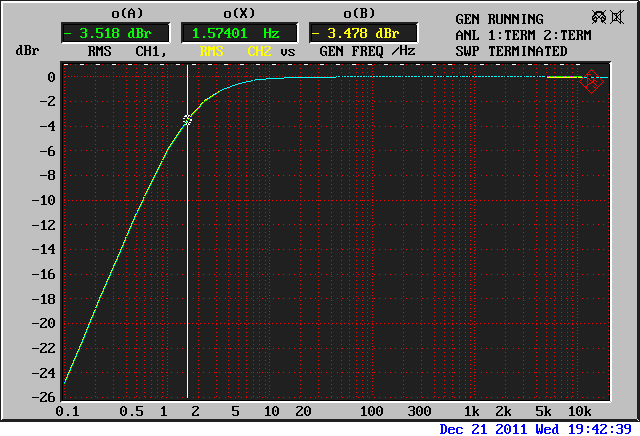
Normal Output Frequency Response to 0.1 Hz, ADCOM GTP-500 II.
The normal (AC-coupled) output is a single-pole (one capacitor) filter, -3 dB at 1.6 Hz. It's a 4.7 µF metallized polyester capacitor in series from the LAB outputs, shunted by 22.1 kΩ.
Maximum Output Levels measurements top
10.9 VRMS at 0.1% THD at 1 kHz, 200k Ω load.
7.3 VRMS at 0.1% THD at 1 kHz, 600 Ω load.
These were unchanged with the Tone Controls active.
See also the Headphone Amplifier Maximum Output Levels.
Output Source Impedance measurements top
I measured the output source impedance, and confirmed that it is 100 Ω as specified, and also within ± 1%!
Distortion measurements top
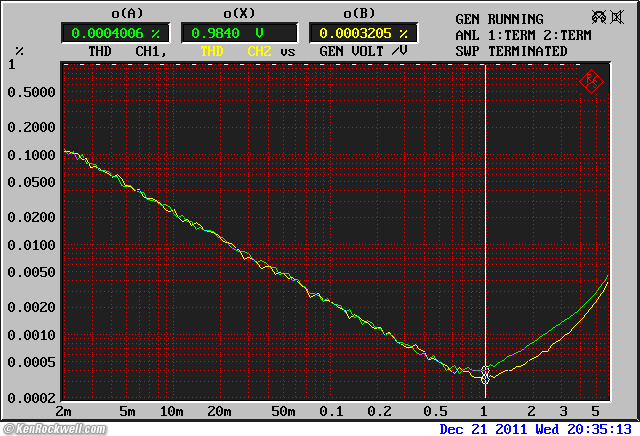
THD, ADCOM GTP-500 II at 1 kHz.
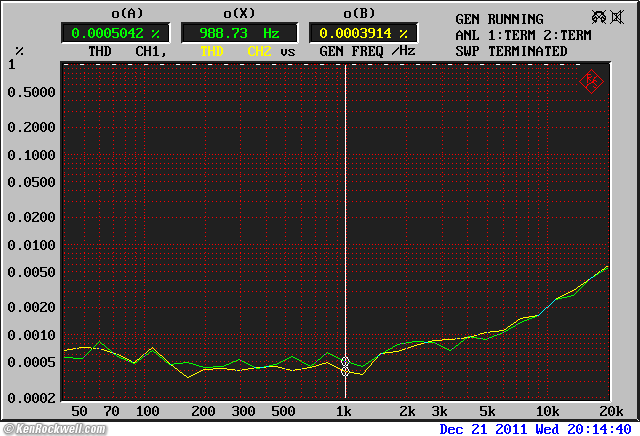
THD, ADCOM GTP-500 II at 1V RMS.
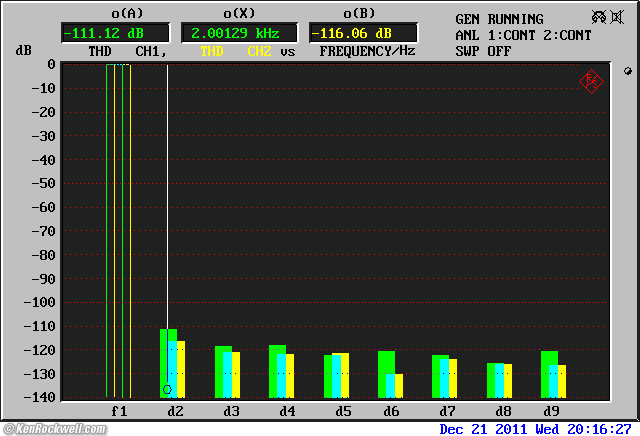
Harmonic distortion components, ADCOM GTP-500 II, 1V RMS at 1 kHz.
Difference-Frequency Distortion measurements top
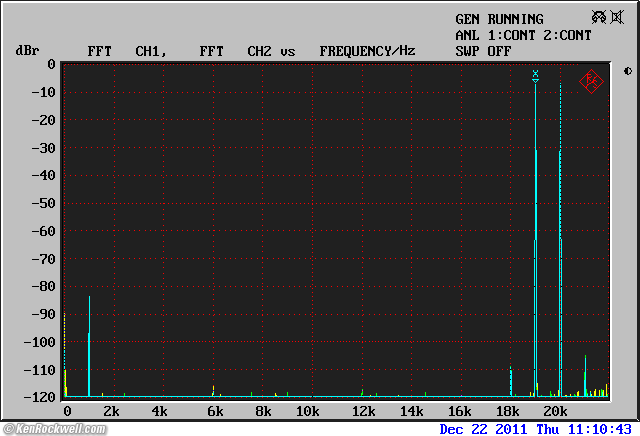
DFD, 19/20 kHz 1:1 at 2V, ADCOM GTP-500 II.
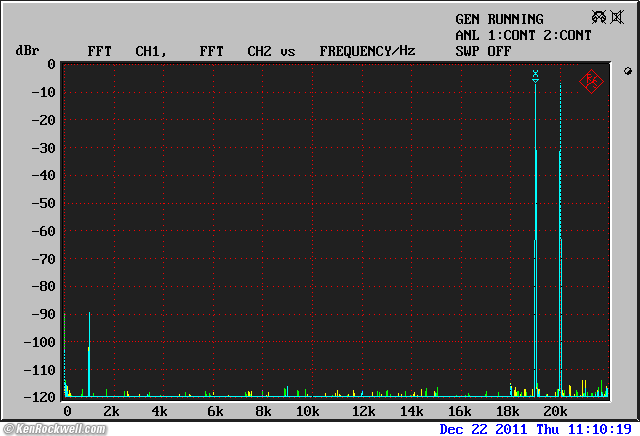
DFD, 19/20 kHz 1:1 at 1V, ADCOM GTP-500 II.
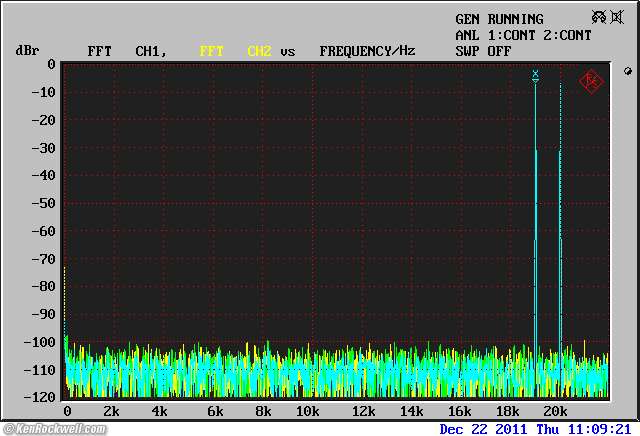
DFD, 19/20 kHz 1:1 at 100 mV, ADCOM GTP-500 II. (distortion lost in noise.)
Gain, Tracking and Balance measurements top
The Attenuator: Gain & Volume Control top
The most important thing a preamplifier does is amplify. The most critical part is the volume control, or attenuator, which can lead to distortion and channel imbalance.
What these next three charts are all trying to say is that the Volume Control is quite ordinary, but it doesn't do anything above 3 o'clock!
System Gain versus Volume Control Setting
Volume Control Setting (O'clock) |
Gain, CD in to LAB out |
Maximum: 5 o'clock |
15.835 dB |
4 o'clock |
15.71 dB |
3 o'clock |
15.25 dB |
2 o'clock |
11.48 dB |
1 o'clock |
5.75 dB |
12:20 o'clock |
0 dB |
Noon |
-5.75 dB |
11 o'clock |
-8.75 dB |
10 o'clock |
-13.8 dB |
9 o'clock |
-29.2 dB |
8 o'clock |
-44.15 dB |
Minimum: 7 o'clock |
-97 dB |
15.835 dB is a gain of 6.191 times.
Volume Control Setting versus System Gain
For this Gain |
Set Volume Control to |
+15.835 dB |
Maximum: 5 o'clock |
+15 dB |
3 o'clock |
+10 dB |
1:40 o'clock |
+6 dB |
1 o'clock |
0 dB (unity) |
12:20 o'clock |
-6 dB |
11:50 o'clock |
-10 dB |
10:30 o'clock |
-20 dB |
9:40 o'clock |
-30 dB |
9:05 o'clock |
-40 dB |
8:10 o'clock |
-50 dB |
7:45 o'clock |
-60 dB |
7:30 o'clock |
Volume Control Attenuation
For this Relative Attenuation |
Set Volume Control at |
0 dB |
Maximum: 5 o'clock |
-1 dB |
3 o'clock |
-3 dB |
2:10 o'clock |
-10 dB |
1 o'clock |
-20 dB |
12:05 o'clock |
-30 dB |
10 o'clock |
-40 dB |
9:15 o'clock |
-50 dB |
8:40 o'clock |
-60 dB |
8 o'clock |
-70 dB |
7:35 o'clock |
Tracking top
Tracking (left-right channel balance versus volume control setting) is pretty decent for a 30¢ ganged pot, but still has some audible imbalance at lower settings. It's nowhere near as good as the Apt Preamp or the Quad 34.
In this graph below, the scale has been compressed to fit the GTP-500 II's much larger imbalance compared to the greatly expanded scale of the graphs for the Apt Preamp and Quad 34. For those better preamps, I've enlarged their scales fifteen times more than below to show inaudible shifts; in the graph below, you'll probably hear anything more than about 2 dB as the image moving to the right.
No big deal, I set the GTP-500 II's Balance control to a little less than about 11 o'clock to compensate at volume control settings of less than 12 o'clock.
![]()
Right channel level versus left channel, vs. volume control setting, clockwise rotation. (positive/up means image moves to right.)
![]()
Right channel level versus left channel, vs. volume control setting, counter-clockwise rotation. (positive/up means image moves to right.)
Balance measurements top
The GTP-500 II has a very conventional balance control that merely attenuates the lesser channel, leaving the other alone.
It doesn't increase gain on either channel slightly as does the Quad 34 to maintain the same overall power output.
Noise measurements top
Measured at the LAB output, as driven from the muted output of the Rohde &Schwarz UPL, with its 5Ω unbalanced source impedance feeding the GTP-500 II's CD input:
Volume Control |
Noise, A-Weighted |
Noise, unweighted |
Maximum |
-94.7 dBV |
-91.7 dBV |
Unity (12:20 o'clock) |
-96.1 dBV |
-93.2 dBV |
Minimum |
-97.5 dBV |
-94.6 dBV |
To convert these dBV readings into signal-to-noise ratios, add the voltage of your output signal. For instance, a CD player's maximum output is +6 dBV, so with -94 dBV of noise, there is a 100 dB signal-to-noise ratio.
The volume control is an ordinary design, so there is no noise advantage at lower settings as we see in the Apt Preamp and Quad 34. I'd like to see less noise coming out of this ADCOM preamp.
Crosstalk measurements top
Idle Input Rejection
Signal heard at LAB output with 300mV at 1kHz fed into CD input and other inputs selected. These inputs were not terminated, so in actual use there ought to be much less:
Tuner selected: -102 dB.
Tape 1 selected: -69dB (input unterminated).
Tape 2 selected : -75dB (input unterminated).
Channel Separation
I was too lazy to measure; who cares?
Contour (Loudness) measurements top
Here is the response of the Contour control at various Volume Control settings:
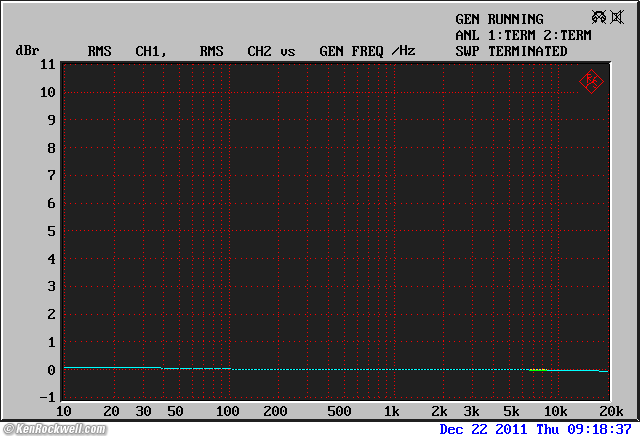
Contour response, volume control at maximum.
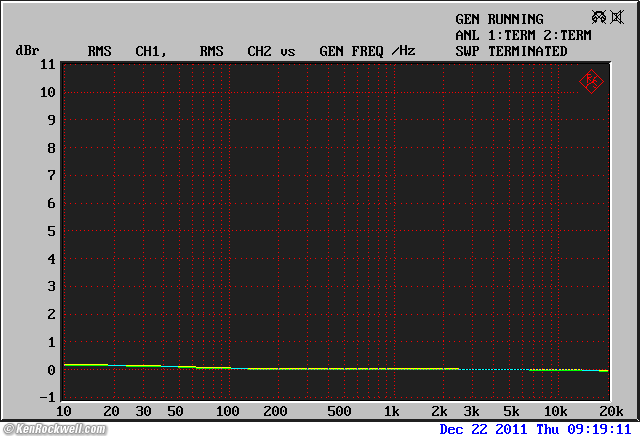
Contour response, volume control at 3 o'clock.
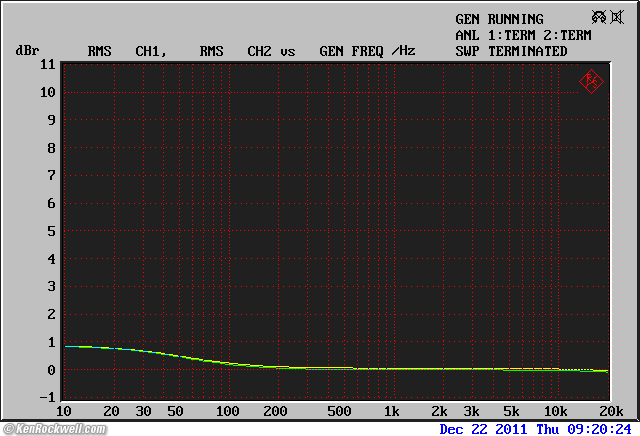
Contour response, volume control at 2 o'clock.

Contour response, volume control at 1 o'clock.
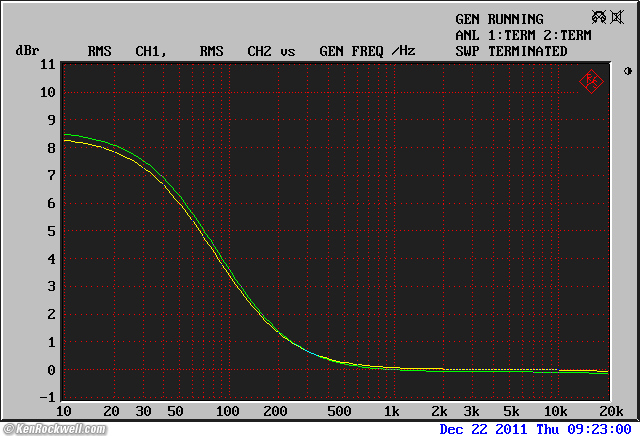
Contour response, volume control at 12 o'clock.
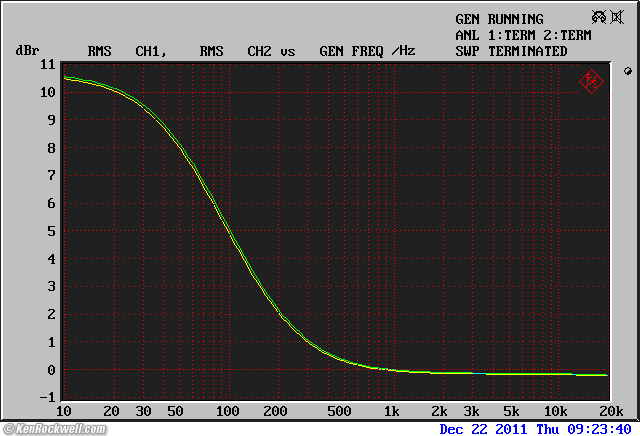
Contour response, volume control at 11 o'clock.
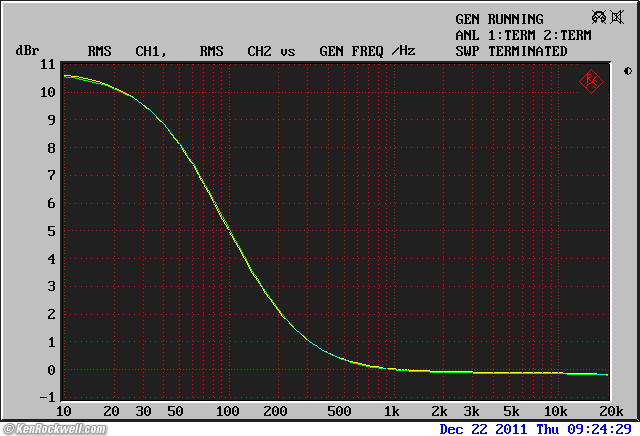
Contour response, volume control at 10 o'clock.
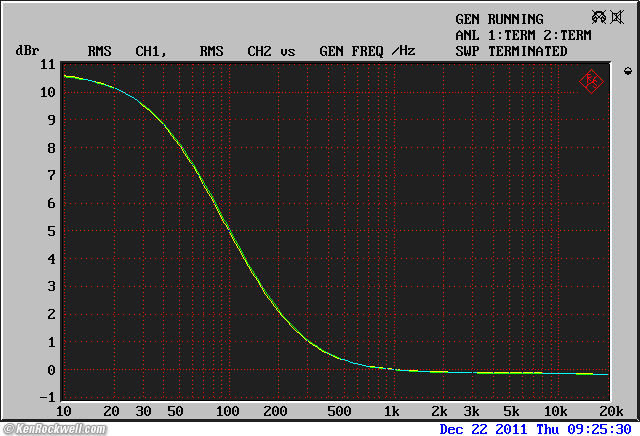
Contour response, volume control at 9 o'clock.
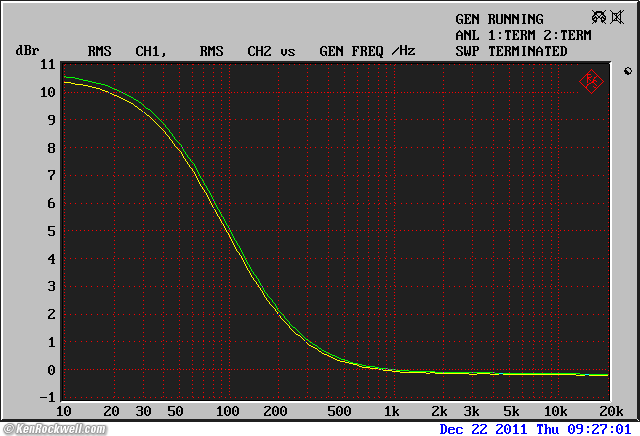
Contour response, volume control at 8 o'clock.

Infrasonic Contour response, volume control at 9 o'clock.
The Contour control boosts all the way down to DC. Watch out!
All these graphs tell us is that the Contour control gives a big boost to the deepest bass, pretty much with the same strength regardless of the position of the Volume control in the softer half of its rotation.
Tone Controls measurements top
Tone Circuit Noise and THD Contribution
There was no measured change in noise levels, THD or maximum output with the tone circuit in or out.
Tone Circuit Gain
The tone control circuits have very slightly less gain than in the usual deactivated position. This slight change is inaudible, measured at 1 kHz, and is the gain relative to the gain in the usual position:
Left |
Right |
-0.0909 dB |
-0.0520 dB |
Frequency Response
The tone control circuit adds one pole (series capacitor), -3 dB at 2 Hz, so we lose DC response with the tone controls, which usually is a good thing.
The 110kHz high-frequency response is unchanged with the tone controls active.
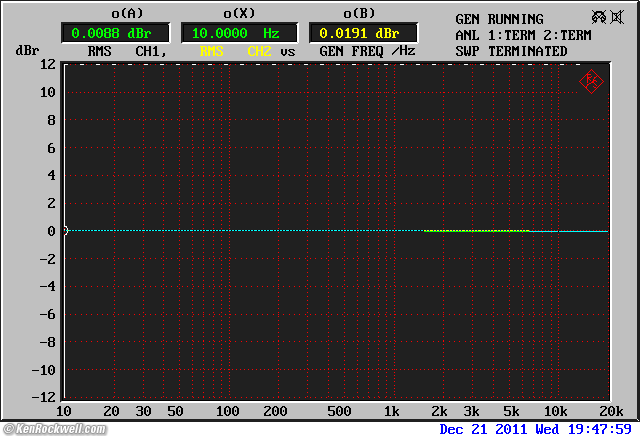
Frequency Response, ADCOM GTP-500 II, tone controls active and set flat.
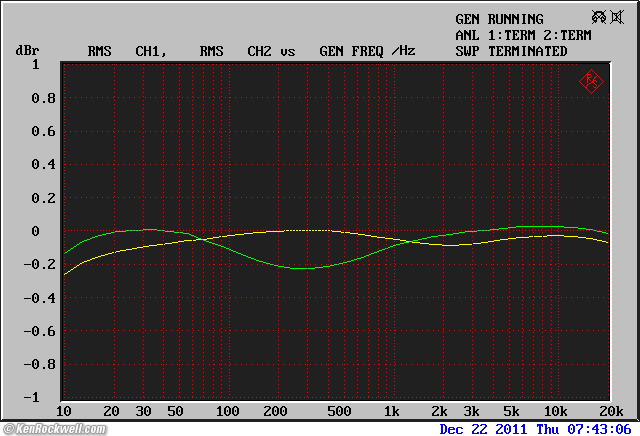
Frequency Response, ADCOM GTP-500 II, tone controls active and set flat, greatly expanded vertical scale.
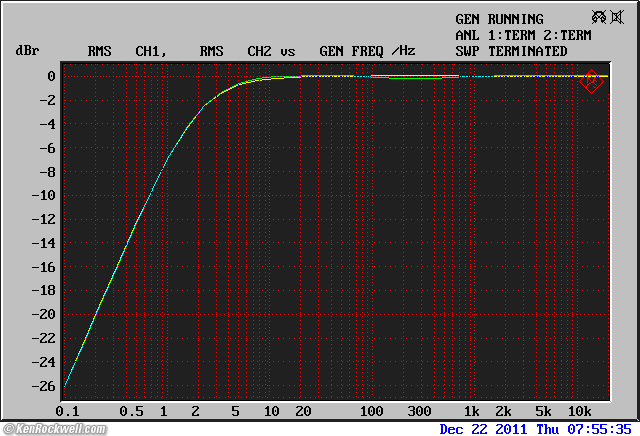
Tone Control Infrasonic Response to 0.1 Hz, controls set flat, ADCOM GTP-500 II.
The tone circuit is not DC coupled.
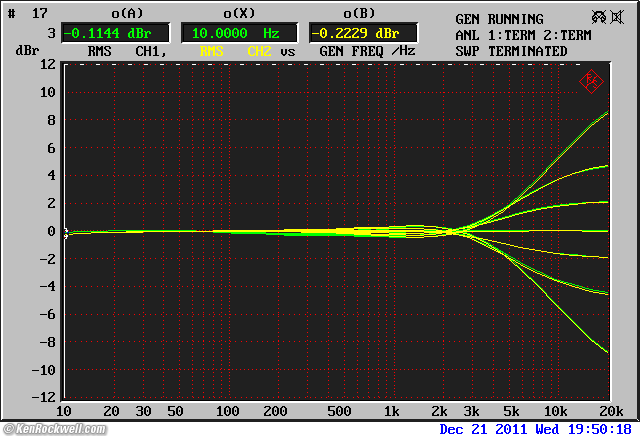
Treble Control Responses, ADCOM GTP-500 II.
For this and the next sets of curves, the controls are each set to full cut, 9 o'clock, 10:30 o'clock, the center detent, 1:30 o'clock, 3 o'clock, and the full boost position.
The response at 1 kHz varies ±0.35 dB with the treble control at its limits.
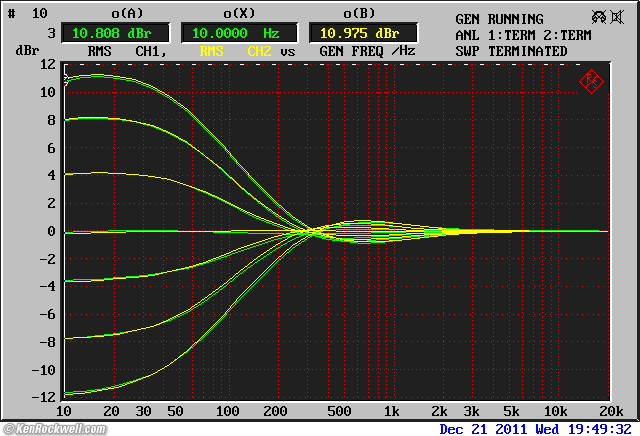
Bass Control Responses, ADCOM GTP-500 II.
The response at 1 kHz varies ±0.6 dB with the bass control at its limits.
Filters measurements top
Other than the intended filtration, there was no measured change in gain, noise levels or THD with the filters active.
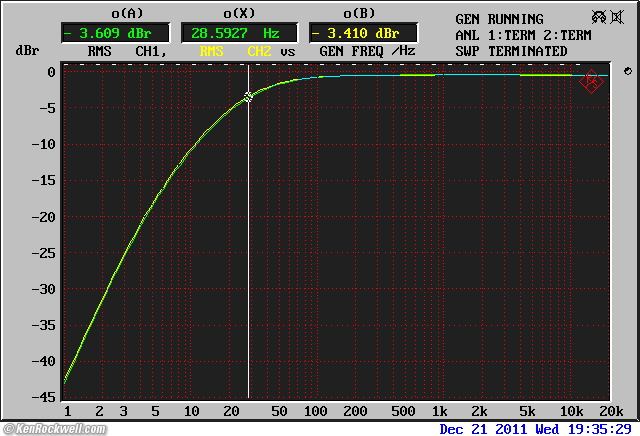
Lo Filter Infrasonic Frequency Response, ADCOM GTP-500 II.
-3 dB at 29 Hz, 12 dB/octave. This is a pretty lame excuse for a rumble filter.
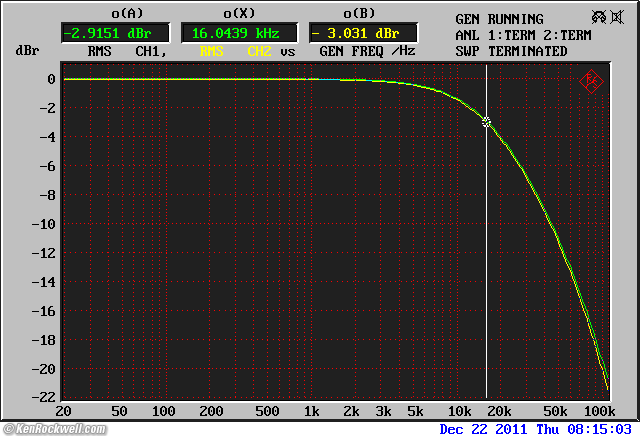
Hi Filter Ultrasonic Frequency Response, ADCOM GTP-500 II.
-3 dB at 16 kHz, 6 dB/octave more than the existing ultrasonic rolloff of the GTP-500 II.
This is an extremely useful, gentle and mild filter for improving distorted or bright recordings, exactly as the more flexible filters of the Quad 34.
Tape Outputs measurements top
There are two tape outputs: TAPE 1 and TAPE 2.
With the CD input selected for the recording output, frequency response was flat ± 0.025 dB from DC to 20 kHz, so I didn't bother to plot it.
Gain from the CD input to TAPE 1 output is -0.3041 dB left, -0.3089 dB right.
With the CD input selected for the Tape output and fed from the muted 5 Ω source of the Rohde &Schwarz UPL, noise measured -113 dBV A-weighted, and -110.2 dBV unweighted. This is very good; I wish the main outputs were this clean.
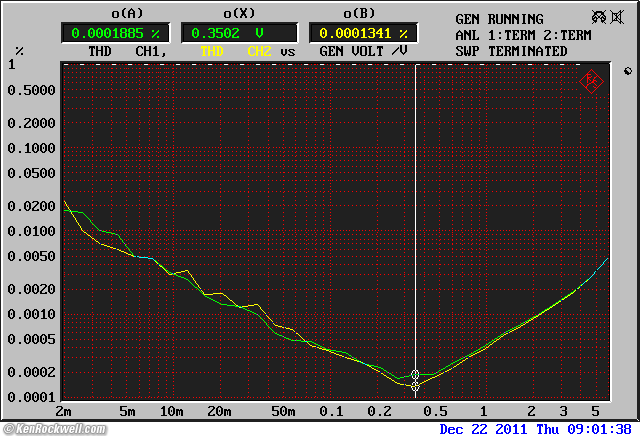
THD, CD in to Tape Output at 1 kHz, ADCOM GTP-500 II.
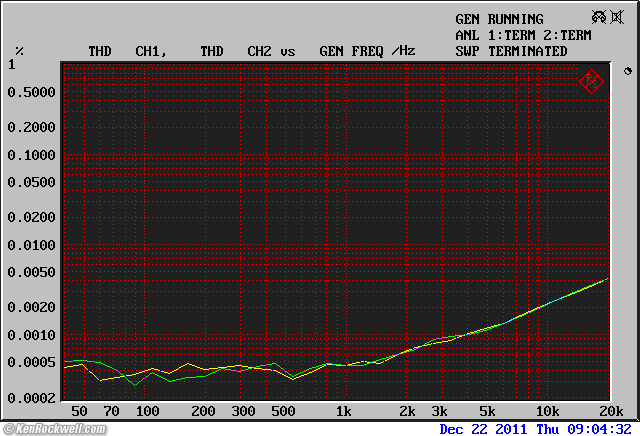
THD, CD in to Tape Output at 1V RMS, ADCOM GTP-500 II.
THD of the tape output is even cleaner than the main outputs, which makes perfect sense since they precede most of the preamp's active circuitry.
Use as an EPL
If we use the Tape Outputs as an external processor loop (select CD to record, feed Tape 1 Out to Tape 1 Input, and listen to Tape 1):
Frequency response is flat from DC to 20,000 Hz ± 0.075dB.
Gain change is -0.2899 dB left, -0.2906 dB right, which is the loss in the tape output.
Phono Preamplifier measurements top
I measured the Phono preamp at the TAPE 1 output. I drove it from the 5Ω source impedance of the R&S UPL.
Gain at 1 kHz is 39.05 dB left, and 39.04 dB right channel.
A-weighted noise, with inputs terminated by the the 5Ω source impedance of the R&S UPL, measures -83 dBV-A left, -88 dBV-A right, and -69 dBV unweighted.
Maximum input level at 1 kHz: 85 mV RMS left, 111 mV right at 0.1% THD, which leads to 7.578V RMS and 9.896 V RMS outputs.
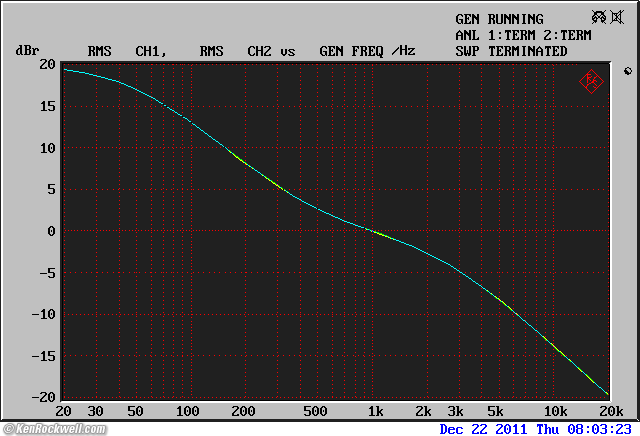
Phono frequency response (showing RIAA curve), ADCOM GTP-500 II.
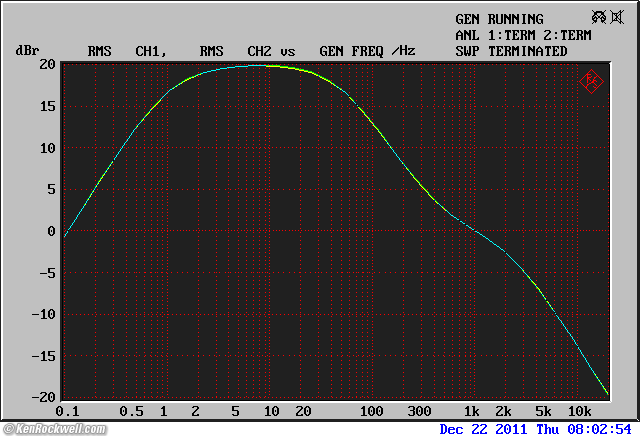
Infrasonic Phono frequency response (showing RIAA curve), ADCOM GTP-500 II.
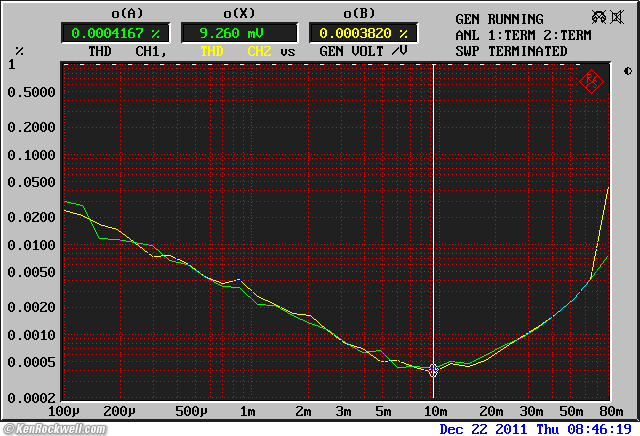
Phono THD at 1 kHz vs. input level, ADCOM GTP-500 II.
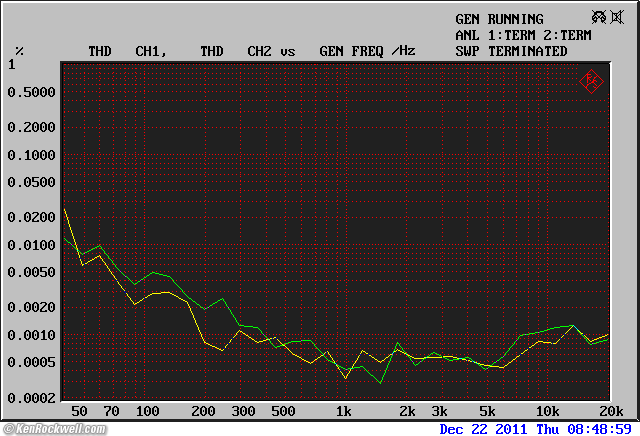
Phono THD at 10 mV RMS input level, ADCOM GTP-500 II.
600 Ω Output Loading measurements top
This has all been with 200 kΩ output loading.
The overall gain drops 1.34 dB when loaded with 600 Ω as predicted by the rated (and measured) 100 Ω output source impedance
Maximum output into 600 Ω measures 7.3 VRMS at 0.1% THD at 1 kHz, unchanged with or without the Tone Controls active.
With a 600 Ω load, frequency response is unchanged.
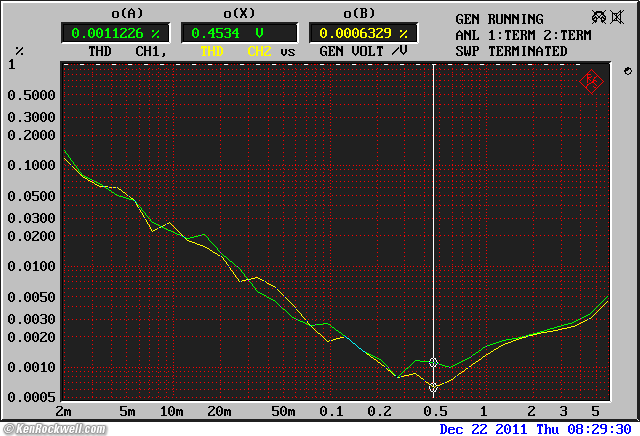
THD into 600 Ω load, ADCOM GTP-500 II.
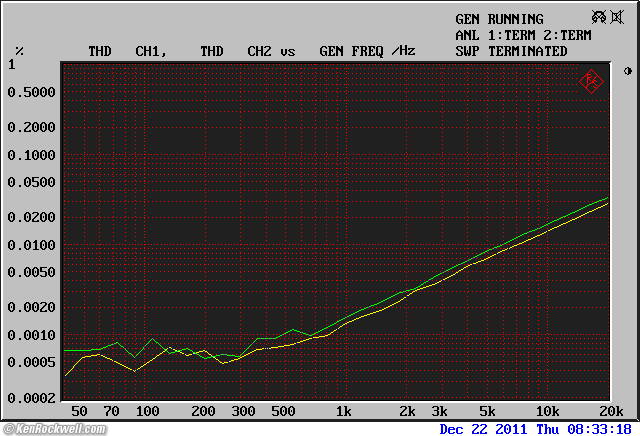
THD, 1 V RMS output into 600 Ω load, ADCOM GTP-500 II.
Distortion is a little bit more when driving a 600 Ω load, but nothing audible. I'd have no qualms using this preamp to drive 600 Ω loads from its LAB output. The Normal output's AC coupling calculates to -3dB at 56 Hz (I didn't bother to measure), so use the LAB output with 600 Ω loads.
Headphone Amplifier measurements top
The headphone amplifier is excellent, except for some minor noise that can be audible with high-sensitivity, low impedance headphones best suited to iPods like the Ultrasone Edition 8. With 600 Ω headphones like the Beyer DT 880, this amplifier sings.
Headphone Amp Gain
Measured at 1 kHz relative to main outputs: 8.290 dB left, 8.299 dB right.
Therefore, for unity gain at the headphone jack, set the volume control to about 11:10 o'clock.
Maximum Output Levels
At 0.1% THD at 1 kHz:
9.53V when loaded by 200k Ω.
8.70V when loaded by 600 Ω (126mW or 21.0 dBm per channel).
7.95V when loaded by 300 Ω (210 mW or 23.2 dBm per channel). Doing this, the GTP-500 II draws 16.5 watts from the 120 VAC supply.
2.32V loaded by 37.5 Ω (143 mW or 21.6 dBm per channel). when doing this, the GTP-500 II draws 18.3 watts from the wall.
For reference, the sensitivity of the 600 Ω (rated) DT 990 is 100dB at 1 VRMS, and 113 dB at 1 V RMS for the 30 Ω rated Edition 8, suggesting 119 dB SPL sinewave maximum for either — at 0.1% amplifier THD.
Headphone Amp Frequency Response
No surprises here, it's as flat as the main outputs, with its own AC coupling: -3 dB at 0.6 Hz.
At 110 kHz, it's response is down only 1.65 dB, or only 0.5 dB less at 110 kHz than the main outputs. I'll skip you the graphs.
Headphone Amp Source Impedance: 0.15 Ω at 1 kHz!
I measured the headphone output source impedance at 0.15 Ω at 1 kHz. This was difficult to do, since I had to null out even the cables involved.
Laymen may be confused by what seem to be 49.9 Ω buildout resistors in the headphone amplifier circuit, however since the negative feedback is taken from after the resistors, the headphone amplifier effectively creates a near-zero output impedance, which is confirmed by my real-world frequency response measurements.
Here's the astoundingly flat actual frequency response driving a real pair of Ultrasone Edition 8. When I plotted the same response of the Apt Preamp driving these headphones, I used a scale ten times looser! The Apt preamp's headphone output source impedance is about one-thousand times greater than the ADCOM GTP-500 II.
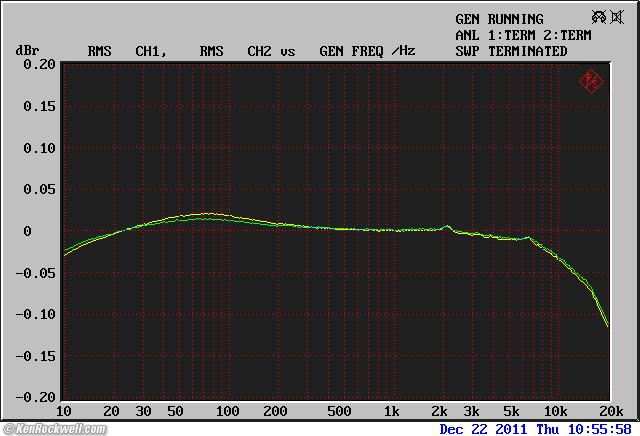
Headphone-output frequency response, driving Ultrasone Edition 8, ADCOM GTP-500 II, extremely expanded scale.
Noise
If set for unity gain at the main output (about 12:20 o'clock): -87.75 dBV A-weighted, -84.8dBV unweighted at the headphone output.
If set to unity gain at the headphone output (about 11:10 o'clock): -88.5dBV A-weighted, -85.5 dBV unweighted.
At minimum gain: -89.1dBV A-weighted, -86.2dB unweighted.
There's a very little bit of background hiss audible (only if music isn't playing) with the highly sensitive 30Ω Ultrasone Edition 8, but with 600Ω Beyer DT880, there is no noise.
Here's where my BSEE and federally-licenced broadcast-engineering magic powers come in. Do you know why we use dBs? Because it makes this all very easy to calculate for useful results. The Edition 8's sensitivity is rated at 113 dB at 1V, so the noise level as heard in the Edition 8 is 25 dB SPL (113dB@1V - 88dBV = 25 dB SPL), and the noise level as heard in the DT880 is 12 dB SPL (100dB@1V - 88dBV = 12 dB SPL). It's easy to hear 25 dB SPL in a closed headphone like the Edition 8 if no music is playing, while we're not going to hear 12 dB SPL in an open headphone, since the ambient noise even in a quiet place like a library is about 30 dB SPL.
Headphone Amp THD
This of course includes the THD of the preamp, from which the headphone amp is fed internally.
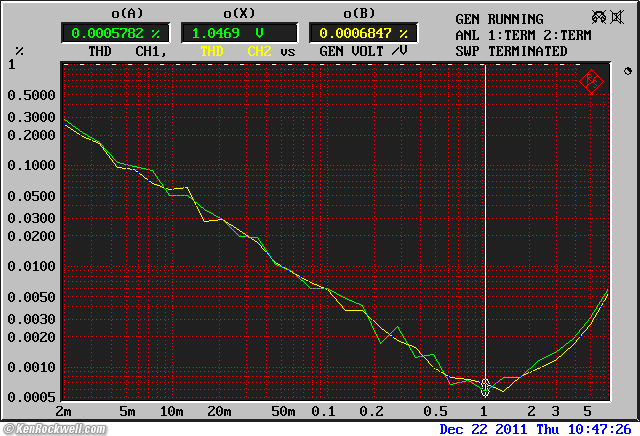
THD vs. level, GTP-500 II Headphone output driving 600 Ω resistor at 1 kHz.

THD, GTP-500 II Headphone output driving 600 Ω resistor at 1V RMS.
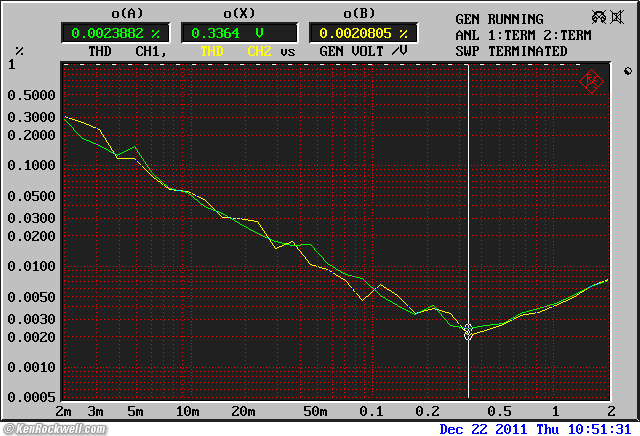
THD vs. level, driving Ultrasone Edition 8 at 1 kHz.
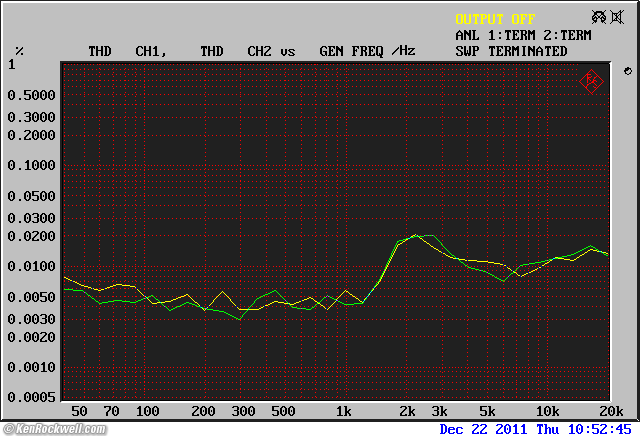
THD vs. level, driving Ultrasone Edition 8 at 200 mV RMS.
Clearly, the ADCOM GTP-500 II easily drives these low-impedance headphones.
Usage top
Intro Specifications Measurements Usage Recommendations More
The front power switch is just a tap-tap switch to toggle the internal power relays — it's not the actual power switch as you'd expect with this vintage.
The two switched outlets are rated 500 VA. ADCOM suggests you might want to plug amplifiers rated at more than 200 WPC directly into the wall, which means that the 200 WPC GFA-555 II seems tacitly approved. I tried it, and the GFA-555 II is perfectly happy running from the switched outlet. The GFA-555 II usually draws only 50 watts from the wall; the higher ratings on the back of the amp are maximums encountered only under full-power sinewave tests.
There is a turn-on delay relay. The mute relay normally shorts the outputs to ground, and a a few seconds after power-on, the relay clicks-on and removes itself from the circuit.
There's no formal pilot light. The pilot lights are the two input selectors and the volume control LEDs, as well as the tuner VFL display.
The tuner display is always active, even if the tuner isn't selected. Regardless of what inputs are selected, the tuner is always on and responds to tuning button pushes.
The MONO control acts before the balance control, as it is in most hi-fi gear.
The Contour control can be left on all the time. If the deep bass or rumble get too much, the Bass control's effect is very similar, so leaving Contour engaged and reducing the Bass control's setting will let you partially cancel the boost of the Contour control.
The LAB output is DC-coupled, and not a good idea unless you're really afraid of capacitors. Use the Normal output, which is AC-coupled and flat down to 1.6 Hz anyway.
Select the inputs for recording or listening with repeated taps of their buttons. They are debounced, so they will ignore you if tapped too quickly. I'd prefer direct-selection, but tough; the remote control does allow one-push selection of any input.
The AM/FM selector switch has longer throw than others, but it's still just a push button that toggles other circuitry — it isn't doing any switching. It has a longer debounce time, so it will ignore you if tapped too quickly.
The Tone Controls are only active when their switch is pressed in.
To store a station, press ENTER (the LED lights), and tap the location into which you want to store it. To cancel the ENTER command, swap bands from AM to FM and back.
The Hi-Blend and UNMUTE functions share a button. If you leave it out, you'll get the best stereo separation, but weaker stations will be muted, and if you leave it in, even the strongest stations will have their highs blended a bit. The good news is that the Hi Blend is subtle and the tuner is so good that there isn't much noise anyway, so if you need to hear weaker stations and are running from the remote control which doesn't have this switch, no big deal leaving it in BLEND.
Use the Hi Filter to remove distortion from scratchy records or brittle recordings.
The Lo Filter is a waste of time, removing deep bass for no good reason and not doing much to remove rumble. If you need a real rumble filter, the Holman Preamp has a much better one.
More tips
See also the ADCOM GTP-500 II Users Manual and the ADCOM GTP-500 II Service Manual.
Recommendations top
Intro Specifications Measurements Usage Recommendations More
For $150 or so today, the ADCOM GTP-500 II is an incredible steal for stereo music enjoyment, especially if you desire a great headphone amp, a tuner, a remote control, better than average Contour and Tone controls, or a capacitor-free signal path.
Its biggest downfall is its cheap volume control pot that sometimes requires a minor tweak of the balance control at lower levels — but its never that far off. If you've found this report helpful, this free website's biggest source of support is when you use these links, especially this link directly to the ADCOM GTP-500 II at eBay (see How to Win at eBay), when you get anything, regardless of the country in which you live. Thanks! Ken.
More Information top
Intro Specifications Measurements Usage Recommendations More
ADCOM GTP-500 II Users Manual.
ADCOM GTP-500 II Service Manual.
Help me help you top
I support my growing family through this website, as crazy as it might seem.
The biggest help is when you use any of these links to Adorama, Amazon, eBay, B&H, Ritz, Calumet, J&R and ScanCafe when you get anything, regardless of the country in which you live. It costs you nothing, and is this site's, and thus my family's, biggest source of support. These places have the best prices and service, which is why I've used them since before this website existed. I recommend them all personally.
If you find this page as helpful as a book you might have had to buy or a workshop you may have had to take, feel free to help me continue helping everyone.
If you've gotten your gear through one of my links or helped otherwise, you're family. It's great people like you who allow me to keep adding to this site full-time. Thanks!
If you haven't helped yet, please do, and consider helping me with a gift of $5.00.
As this page is copyrighted and formally registered, it is unlawful to make copies, especially in the form of printouts for personal use. If you wish to make a printout for personal use, you are granted one-time permission only if you PayPal me $5.00 per printout or part thereof. Thank you!
Thanks for reading!
Mr. & Mrs. Ken Rockwell, Ryan and Katie.
Home Donate New Search Gallery Reviews How-To Books Links Workshops About Contact





